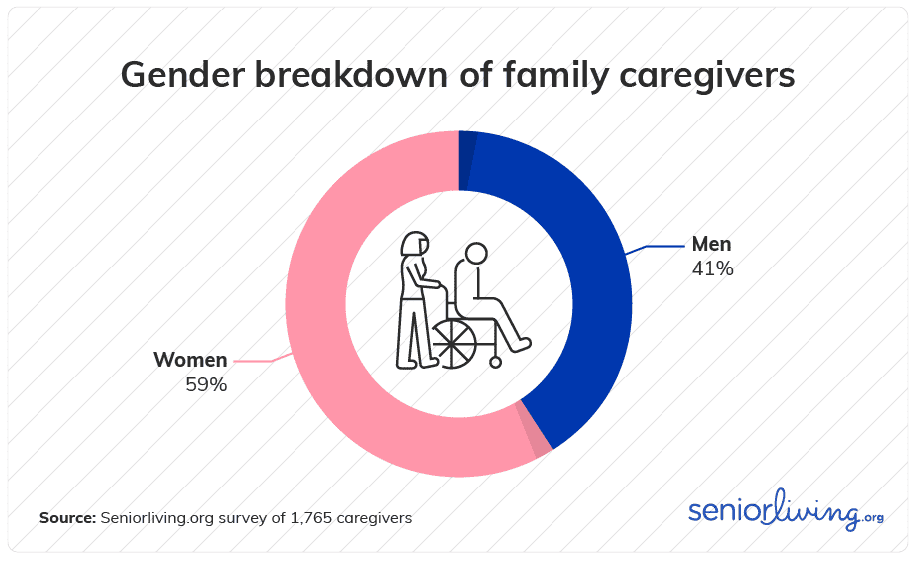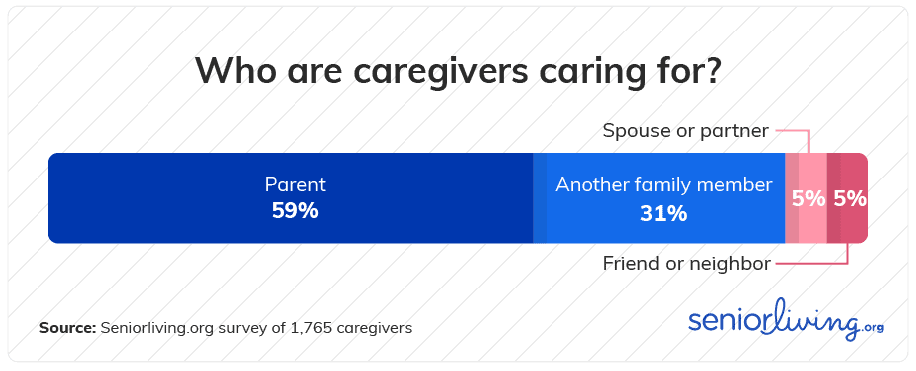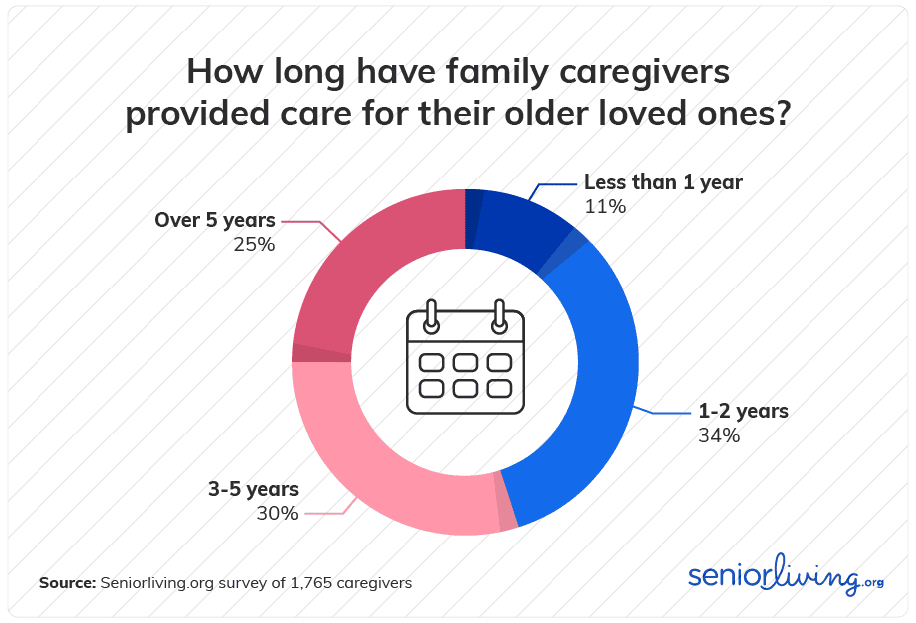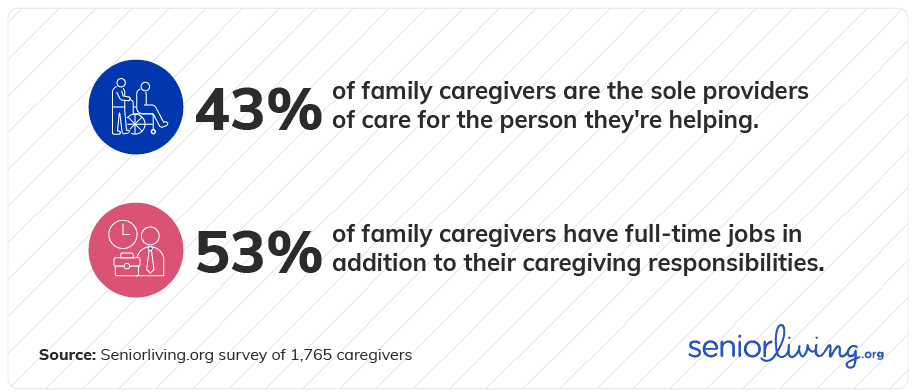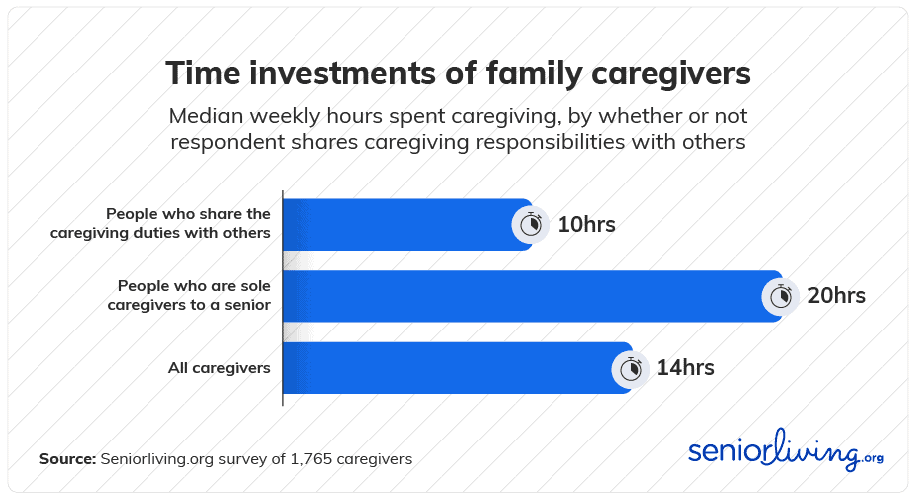Family Caregiver Annual Report and Statistics 2024
America's Silent Workforce: Understanding the Pressures on America's Unpaid Caregivers

SeniorLiving.org is supported by commissions from providers listed on our site. Read our Editorial Guidelines
Table of Contents
About 53 million U.S. adults are family caregivers,1 assisting their older relatives, spouses, friends, or neighbors with daily tasks like cooking and dressing. This means one in five Americans is a caregiver. As the population ages, with projections showing that by 2030, people aged 65 and older will outnumber children,2 the need for family caregiving is expected to grow even more.
Given family caregiving's prevalence and growing importance, SeniorLiving.org sought to better understand this evolving landscape by conducting a comprehensive study of more than 1,700 unpaid family caregivers. The results of our research, combined with insights from other industry leaders, provide deeper insights into the state of family caregiving in the United States.
Key Findings:
- 59% of family caregivers are women, and they report higher levels of emotional stress, depression, and challenges with balancing caregiving duties compared to men.
- 43% of caregivers are the sole providers of care, typically spending 20 hours per week on caregiving duties.
- 53% of family caregivers work full-time jobs, meaning they must balance their caregiving and workplace responsibilities.
- Nearly half (47%) of caregivers receive no formal support, such as financial aid, counseling, or respite care, despite 88% saying they need more help.
- 43% of family caregivers report sleeping difficulties and 36% report feelings of depression.
- While 65% of caregivers haven’t participated in support groups, those who have preferred online forums and Facebook groups over in-person meetings.
What is a Family Caregiver? The term is something of a misnomer, as family caregivers aren’t all necessarily related to the people they care for, though that is the most common arrangement in our research. Broadly, the term refers to someone who provides unpaid assistance to an individual who needs help completing one or more tasks of daily living, like dressing, bathing, or cooking, or who performs specific medical tasks like administering medication.
Family Caregivers Are Mostly Working Women Who Care for Aging Parents
According to our research, women are more likely than men to be family caregivers: 59 percent of respondents were women. The oldest family caregiver in our survey was 95, but the median participant was 42 years old. At this age, most people are still in the workforce, and many are also caring for their children and an older adult for whom they provide care.
Nearly 60 percent of caregivers in our survey cared for a parent while caring for a spouse, friend, or neighbor was much less common.
Many family caregivers are responsible for caring for multiple older adults at once. Nearly one in four caregivers we surveyed cared for more than one person. This means their caregiving duties are often doubled or more.
Furthermore, caregiving tends to be an ongoing responsibility for most. Over half of the caregivers we surveyed (55 percent) had cared for a family member or friend for at least three years. While this suggests they may have gained experience and skills over time, it raises concerns about potential physical and emotional burnout.
An additional factor contributing to caregiver burden is the frequency of sole caregiving. More than 40 percent of family caregivers in our survey were the only caregivers for the individual they were assisting. Without the ability to share responsibilities, these sole caregivers face heightened demands on their time and resources.
The burden is much more significant for sole caregivers than those who share the responsibilities, and many caregivers are balancing work and care responsibilities. Our survey found that sole caregivers typically spend 20 hours per week on caregiving, double the 10 hours spent by those with shared caregiver duties.
The time and tasks involved in caregiving vary widely depending on the care recipient's needs. Some caregiving may be relatively simple, like providing transportation to medical appointments. Others may be expected to perform complex medical or nursing tasks, such as medication management or administering injections.
AARP data shows that nearly 60 percent of caregivers assist with medical or nursing tasks. Other typical caregiver responsibilities include transportation (80 percent), shopping (78 percent), housework (76 percent), and meal preparation (64 percent).
The most common reasons older adults require unpaid care are old age (16 percent), mobility issues (12 percent), Alzheimer's/dementia (11 percent), cancer (six percent), and mental illness (five percent). Old age is the single biggest reason, but many other health conditions also necessitate family caregiving.3
| Where does the person you care for live? | Percent of caregivers |
|---|---|
| With me, their partner, or with a roommate | 62% |
| Alone | 31% |
| Senior housing | 7% |
It’s rare for family caregivers to have the assistance of senior housing, meaning they must help older adults manage to live independently or with a spouse or family member — and older adults often reside with their family caregivers. Among our survey participants, only seven percent help provide care for an older adult living in senior housing.
It’s not uncommon for older adults who receive care from a friend or family member to reside in that person’s home. In 2022, our research revealed that 43 percent of caregivers lived with the care recipient, and other cultural research has indicated that multigenerational households may become even more common.
According to the Pew Research Center, the rate of multigenerational homes more than doubled between 1971 and 2021, rising from seven percent to 18 percent, and almost 60 million Americans live in such households.4
Among all older adults, just over a quarter live alone, according to the U.S. Census Bureau.5
Pro Tip: For seniors requiring more continuous support, live-in home care options can provide a valuable alternative, helping to meet their daily needs without the need to relocate.
Top Challenges for Family Caregivers
Family caregiving takes a heavy emotional toll for many: nearly three-quarters of caregivers in our study reported stress as a significant difficulty. Balancing caregiving with other responsibilities is also a common challenge.
However, there’s a notable difference between men and women caregivers. Women are more likely to mention emotional stress, struggles with balance, setting boundaries, and even depression, while men are more likely to report financial strain as their main issue.
| Which of the following difficulties have you experienced as a caregiver? | All family caregivers | Male caregivers | Female caregivers |
|---|---|---|---|
| Emotional stress | 72% | 66% | 77% |
| Balancing caregiving with the rest of my responsibilities or desires | 66% | 61% | 70% |
| Financial strain | 51% | 52% | 49% |
| I feel obligated to help because no one else will | 48% | 44% | 51% |
| Loss of sleep | 43% | 43% | 43% |
| Physical demands | 41% | 36% | 44% |
| Setting boundaries with how much time I commit to caregiving | 38% | 30% | 43% |
| Depression | 36% | 32% | 38% |
| I need more help but don’t want to ask | 25% | 24% | 25% |
| No difficulties | 2% | 2% | 0% |
Note: Multiple responses allowed
Approximately 36 percent of family caregivers said they’ve experienced depression since they became caregivers, which is higher than the rate of depression in the general public. According to a Gallup study, 29 percent of U.S. adults said they’d been diagnosed with depression at some point in their lives.6
Given the potential health impacts of depression, it’s essential for caregivers with the condition to reach out for help. One-quarter of caregivers said they want help but are afraid to ask, and in many cases, they simply want someone who has been there to commiserate with.
Sixty-two percent of caregivers agree with the statement, “I wish I could talk to other caregivers who understand what I’m going through,” though women were much more likely to say talking things out would be helpful.
Similarly, 56 percent of caregivers say they need reliable tips about day-to-day caregiving, further highlighting the importance and need for a community approach to tackling this issue.
| Have you ever participated in these types of caregiver support groups? | All family caregivers | Male caregivers | Female caregivers |
|---|---|---|---|
| In-person support group | 10% | 12% | 10% |
| Video group meetings | 5% | 7% | 4% |
| Online chat groups | 13% | 15% | 12% |
| Facebook groups | 14% | 9% | 17% |
| Online forums or message boards | 17% | 19% | 15% |
| None | 65% | 65% | 66% |
Note: Multiple responses allowed
Though most caregivers say they need help with their duties, nearly two in three (65 percent) have not participated in any caregiver support groups, which are easily accessible. Among those who have participated, online forums, message boards, and Facebook groups are more popular than in-person support groups, highlighting the need to reach caregivers where they are instead of creating barriers to access.
The Financial Impact of Caregiving
The financial impact of caregiving was one of the challenges most commonly cited by family caregivers in our survey. When looking at broad national statistics, it’s incredibly easy to see why: Unpaid caregiving has an economic impact of more than $600 billion, according to AARP’s estimates,7 a figure that doesn’t even account for things like lost wages, out-of-pocket costs, or the time involved in medical-related tasks caregivers are providing.
On average, family caregivers spend more than $7,200 per year out of pocket, or about one-quarter of their annual income.8 Due to inflation, this figure is almost certainly higher now than when AARP initially conducted its financial impact research in 2021.
Out-of-pocket costs for family caregivers run the gamut from home renovations and housing costs to prescription drugs and medical supplies. Among medical expenses these individuals provide for older adults, AARP’s Family Caregivers Cost Study showed that payments to providers or hospitals take the lion’s share, accounting for 43 percent of medical-related costs covered by caregivers, followed by prescription drugs (13 percent) and medical supplies or equipment (11 percent).
Family caregiving generally requires people to make sacrifices, as we’ve seen, giving up their time, energy, and money. But it can also cause them to make sacrifices at work. An AARP survey indicated that 50 percent of family caregivers have gone in late, left early, or taken time off to accommodate family caregiving. In comparison, one-third have taken a leave of absence, and about 16 percent have gone so far as to forgo a promotion.
Some family caregivers may even have to put off their own retirement. A 2024 study by Columbia's Mailman School of Public Health and Otsuka Pharmaceuticals found that many caregivers forgo retirement contributions to make ends meet for the older adult for whom they provide care, and the effect is worse the younger the caregiver.9 The report found that compared to non-caregivers, these individuals are at risk of a 90 percent reduction in their retirement savings.
Caregiving Support and Resources
Finding resources and support for family caregivers can be challenging, especially since many balance caregiving with full-time jobs. Despite the demands of their role, nearly half of caregivers receive no help, such as counseling, support groups, respite care, or financial assistance.
>> Related Resource: How to Find and Hire a Caregiver for Seniors
Men providing family caregiving are more likely than women to receive support, but there are gender differences depending on the type of support. For example, men are much more likely than women to receive financial support (20 percent vs. 13 percent).
| Which types of caregiver support do you currently receive? | All family caregivers | Male caregivers | Female caregivers |
|---|---|---|---|
| Individual counseling to help cope with giving care | 11% | 10% | 11% |
| Support groups | 8% | 8% | 7% |
| Support from my loved one’s physicians | 24% | 25% | 24% |
| Respite care (short-term or long-term breaks for people who provide care) | 8% | 6% | 9% |
| Financial support | 16% | 20% | 13% |
| Information or classes about giving care, such as giving medications | 12% | 13% | 11% |
| Help in getting access to services | 21% | 24% | 19% |
| I don’t currently receive any of these types of support | 47% | 44% | 50% |
| Accommodation from my employer (among employed) | 13% | 14% | 13% |
Note: Multiple responses allowed
Most caregivers said they could use some support, with financial help being the most cited—58 percent listed it as one of their top three needs. Other commonly needed supports include help accessing services, respite care, and individual counseling. Gender differences also emerged: male caregivers were more likely than women to say they needed more accommodations from their employers, possibly reflecting assumptions that men are not as involved in caregiving.
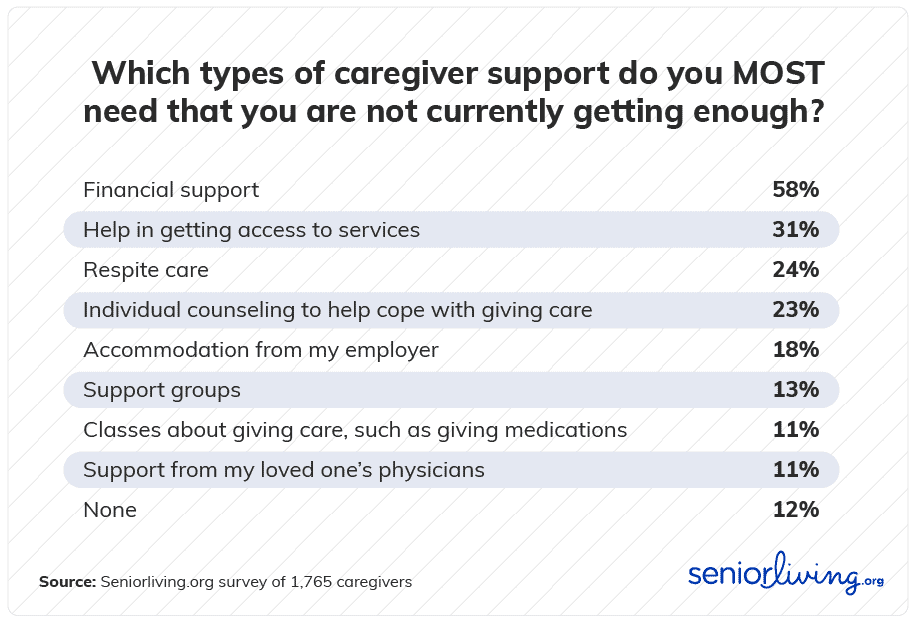
Resources for Family Caregivers
For family caregivers who struggle to maintain their own mental health and balance their needs with those of their loved one, it’s easy to assume you’re on your own. But it’s important to remember that a mentally healthy caregiver can provide better care to their loved one.
Evan Falchuk, CEO of Family First, which provides employer caregiver benefits, understands the importance of balancing caring for self and others. “I always think of what they tell you on an airplane: put on your own oxygen mask before helping others. It's hard to succeed as a caregiver if you're not putting your own health and well-being first…I encourage people to look to their family and friends, to find a support group, and to seek out mental health counseling. Above all, know that you are not alone – there are a lot of people who care about you and who want to help,” he said.
While many more resources are needed to support the growing needs of caregivers fully, here are a few starting places for those who are looking for more help now:
Eldercare Locator
A service of the U.S. Administration on Aging, the Eldercare Locator lets you type in your ZIP code or city and state and find dozens of organizations supporting older Americans and their caregivers, such as their local Area Agency on Aging.
Caregiver Action Network
A nonprofit grassroots organization, Caregiver Action Network offers online support tools, chat, and news about family caregiving.
Medicare/Medicaid Benefits
In some cases, family caregivers may be able to get financial support from Medicare/Medicaid via self-directed services. Eligibility depends on the state, and enrollment may be a challenge. However, for families that can participate, the cost savings could be significant. Those with Medicare Advantage plans are also eligible for additional caregiver benefits.
VA Family Caregiver Assistance
Many benefits are available for family caregivers of U.S. military veterans. For those who qualify, caregivers can receive education and training, mental health counseling, and financial assistance when traveling with the veteran to receive care. Monthly stipends and respite care are also available.
Caregiver Support Groups
Whether online or in-person, support groups can provide caregivers with a community of others who understand their needs and concerns. Groups are typically free to join and run in a variety of formats. There are also groups oriented around conditions like Alzheimer’s or geared toward younger caregivers.
Methodology
In October 2024, we conducted an online poll of 1,765 adults who currently provide unpaid care to someone 55 or older.
AARP. (2020). Caregiving in the United States 2020.
AARP. (2018). Age 65+ Adults Are Projected to Outnumber Children by 2030.
AARP. (2020). Caregiving in the U.S.
Pew Research. (2022). Financial Issues Top the List of Reasons U.S. Adults Live in Multigenerational Homes.
United States Census Bureau. (2024). Older Adults in the United States: 2019 and 2022.
Gallup. (2023). U.S. Depression Rates Reach New Highs.
AARP. (2023). New Report Highlights Increasing Cost of Family Caregiving in the U.S.
AARP. (2021). CAREGIVING OUT-OF POCKET COSTS STUDY.
Otsuka. (2024). New Report Reveals U.S. Family Caregivers Perform Equivalent of a Staggering $873.5 Billion Worth of Labor, Would Surpass Revenue of Top Global Companies.

